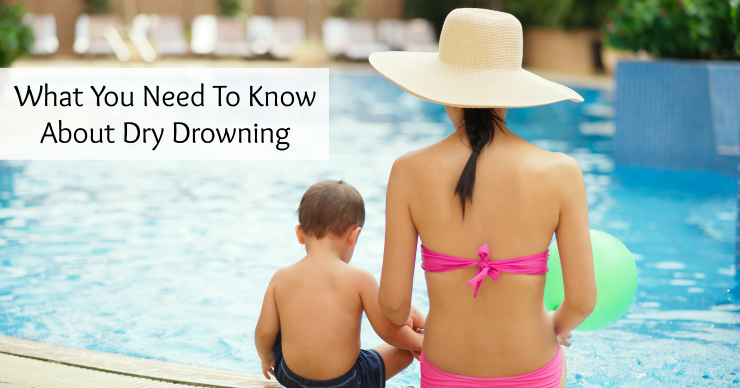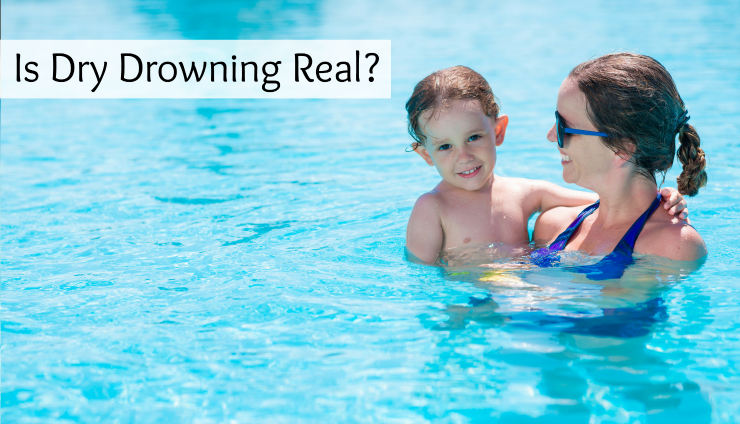Your Kids Aren’t Dry Drowning (Because It’s Not Real)
June 27, 2018
I received a lot of great responses after publishing this post about dry drowning symptoms. So many parents are concerned about their children dry drowning, and it’s been great to set some of those fears to rest. I’ve updated the end of this post with more water safety tips and a free printable — my hope is that this resource will help you keep your kids safe in the pool, open water, and even the bathtub.
You know there is an issue when medical providers are learning medical terms from social media, and not the other way around. That’s exactly what happened to me (and many of my colleagues) with dry drowning.
A few summers ago, I read about dry drowning for the first time on Facebook. Since then, this misrepresented drowning condition has struck fear into the hearts of parents across the country. With reports that a child in Texas died from dry drowning this month, concern over this topic is making its rounds through parenting circles again, and it’s showing up in our exam rooms, too.

Are these dry drowning symptoms?
At urgent care, I’ve been getting questions regularly regarding dry drowning. Parents are usually a little hesitant to voice their concern, but their questions about dry drowning symptoms usually go like this:
“I think my son might have swallowed some water in the bath tub last night, should I be concerned about dry drowning? I was so scared to put him to bed.”
“A few days ago, my daughter was playing the pool and coughed a few times after jumping in the water. She said she got water up her nose. Is dry drowning a possibility?”
The situations these parents are describing happen to all children at some point! It’s extremely normal for a child playing in the water to experience these things, but parents are worried there is a greater danger and their children are experiencing symptoms of dry drowning. I hear those fears. I understand. There are many, many legitimate concerns and threats to protect our children from. But thankfully, dry drowning isn’t one of them, and it doesn’t have to keep you up at night.
Dr. Katherine Hensley summarized the feelings of the entire pediatric community when she said this,
“In short, your child is not going to go swimming, swallow some water, have no issues in the water whatsoever, and then suddenly die without warning 4 days later from ‘dry drowning.’ I know the stories you’ve been reading, they’re all over my newsfeed, too. I know how the thought of losing your child makes you have actual physical chest pain because it does that to me too…. But I don’t want the kids of the world never going near the water again because their parents were frightened by a poorly researched Facebook article.”
Dry drowning is not an accepted medical condition. Neither is near-drowning or secondary drowning. In fact, most organizations discourage the use of these terms entirely because of their confusing nature — this includes the World Health Organization, the International Liaison Committee on Resuscitation, the Wilderness Medical Society, the Utstein Style system, the International Lifesaving Federation, the International Conference on Drowning, Starfish Aquatics Institute, the American Heart Association, the American Red Cross, and the U.S. Centers for Disease Control and Prevention. This is why most medical providers are hearing about dry drowning for the first time on social media.
What Is Drowning?
For the sake of simplifying the true medical terminology, drowning is…drowning. The official definition of drowning is “the process of experiencing respiratory impairment from submersion/immersion in liquid.” It’s important to understand, though, that drowning can have three different outcomes. Drowning can result in:
- Fatal drowning (death is caused by drowning)
- Nonfatal drowning with injury or illness (patient survives drowning but has some type of bodily damage)
- Nonfatal drowning without injury or illness (patient survives without bodily damage)
Instead of associating drowning immediately with death, the medical community looks at drowning as a spectrum, ranging from mild damage to death.

What Is Dry Drowning?
So, what is dry drowning, and what are the dry drowning symptoms you should look for? Because dry drowning has never been an accepted medical term, it’s challenging to describe what has been largely influenced by different media sources.
Dry drowning was previously used to describe the lungs of drowning victims that contained no water during autopsy. This happens in 10-20% of drowning cases, and may be related to laryngospasm. However, we know that very little water actually enters the lungs during most drownings (usually less than 2mL/kg, for reference that’s less than one ounce in a child who weighs 33lbs). So, this is what parents need to remember: in drowning situations, the main medical problem is lack of oxygen to the brain. Whether there is water in the lungs or no water in the lungs at the time of drowning, the problem is still a lack of oxygen to the brain. The wet versus dry terminology is irrelevant, and because it doesn’t change the treatment, drowning specialists no longer use these distinctions.
Dry drowning has also been used interchangeably with secondary drowning. Secondary drowning is not a medically accepted term, either, but it carries a fearful connotation for many parents that children can inhale a small amount of water and die days later. Biologically this concept revolves around a disease process called pneumonitis. When children aspirate (inhale) water, it can disrupt the surfactant lining of the lungs. Sometimes this can trigger inflammation and fluid build-up in the lungs.
The take-home message I want parents to know about so-called secondary drowning symptoms is this: This is very rare. You don’t have to be overly fearful of “missing” pneumonitis in your child. You won’t accidentally overlook it. This isn’t a situation where you feel guilty because your kid fell down, looked fine, and you waited too long to get an x-ray of their unknowingly broken arm. Children experiencing pneumonitis will have clear, worsening symptoms, including coughing, wheezing, inability to catch their breath, vomiting, extreme fatigue, and disorientation.
As Dr. Seth Hawkins said in his highly informative review on dry drowning,
“There has never been a case published in the medical literature of a patient who received a clinical assessment, was initially without symptoms, and who later deteriorated and died. People who have drowned and have minimal symptoms will either get better or worse within two to three hours.”
If your child has a drowning episode, go immediately to the ER (please skip your pediatric office or urgent care, they will just send you to the ER, too, so you don’t need an extra medical bill!). Any coughing episode that lasts longer than several minutes following your child being immersed under water deserves medical evaluation.
Let’s not allow the confusion caused by dry drowning to distract us from the real enemy that drowning is to our children. Drowning is the leading preventable cause of death in children. About one in five people who die from drowning are children 14 and younger. For every child who dies from drowning, another five receive emergency department care for nonfatal submersion injuries.
Water Safety Tips To Prevent Drowning
- Watch children around water. Always. Supervision is key to prevention. Be within arm’s reach of toddlers, this is known as touch supervision, and it is critical.
- Every child needs taught how to swim. Please teach them to swim, and give them a refresher at the beginning of each summer. I especially think teaching young children to exhale under water by blowing bubbles really lessens the likelihood of them accidentally inhaling water by trying to gasp in a breath to hold. A simple method for teaching this skill is encouraging children to take a deep breath, put their mouth in the water, and then hum their favorite song.
- Learn CPR. If your child is invited to a pool party, ask if there will be an adult there who knows CPR.
- Please, please throw away your children’s arm floaties. I cringe inside when I see little children wearing them. They are way too easy for children to remove and they inappropriately instill confidence in children and parents. If you really want to use a flotation device with your child, use a Coast Guard-approved life jacket.
For more water safety tips, download my free water safety printables, with tips for keeping your kids safe in swimming pools, open water, and even the bathtub!
Click here to download your FREE water safety printable!
One last thing. If you are unsure about any symptoms your child is experiencing, or you are concerned about the information you’ve read in an article, never be afraid to consult your pediatric provider. That’s what we are here for.
Now that you know that you don’t have to be concerned about dry drowning, you can focus on real drowning prevention and have fun swimming with your kids this summer.
Author: Dani Stringer, MSN, CPNP, PMHS – founder of KidNurse and MomNurse Academy